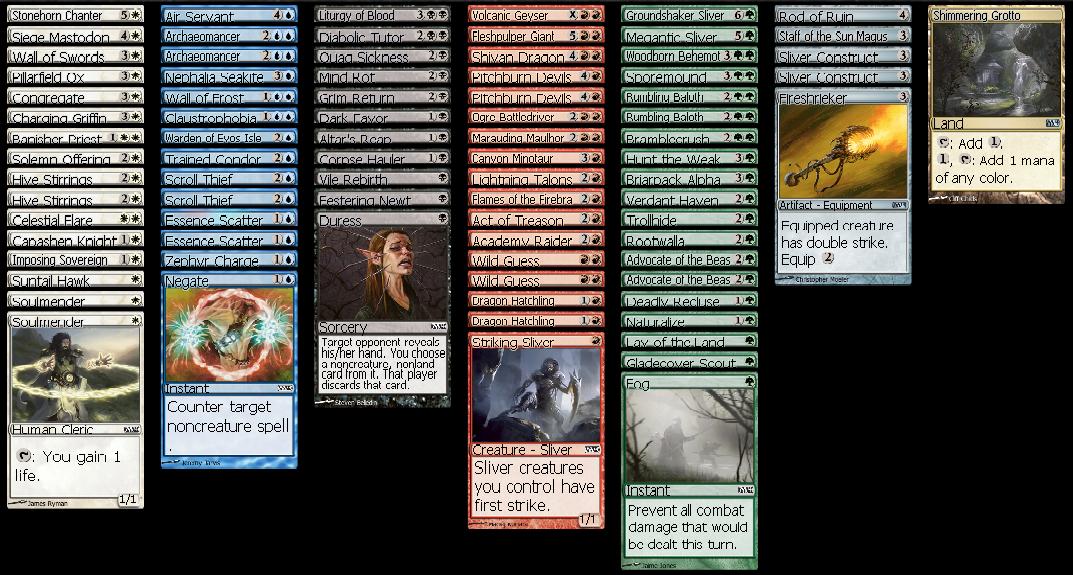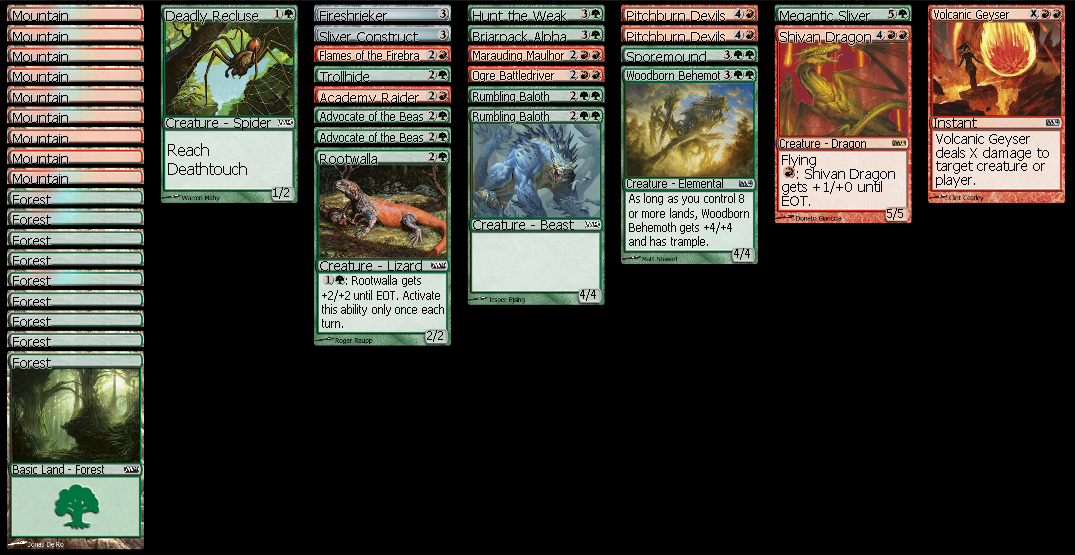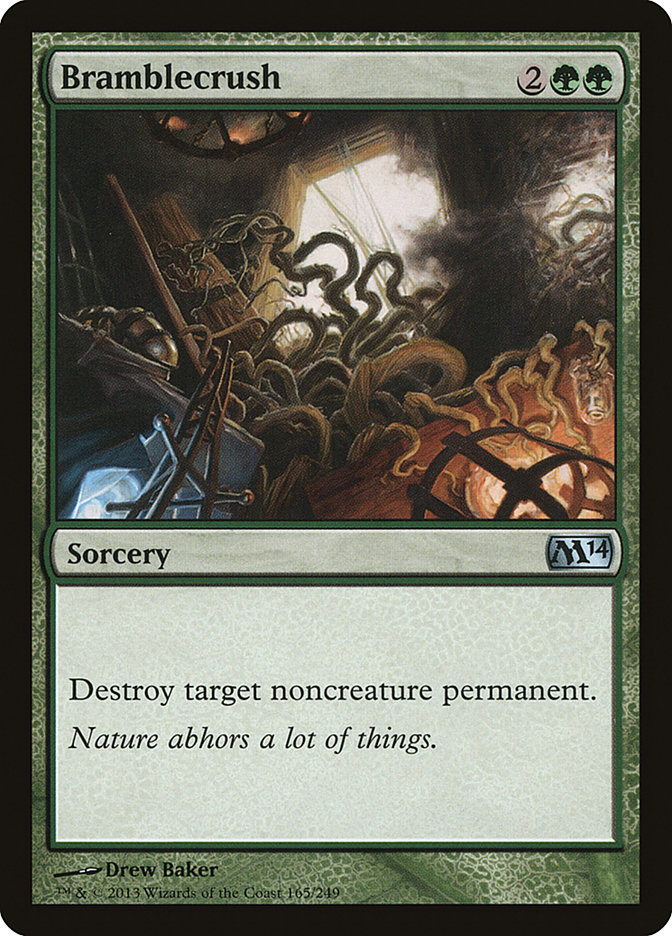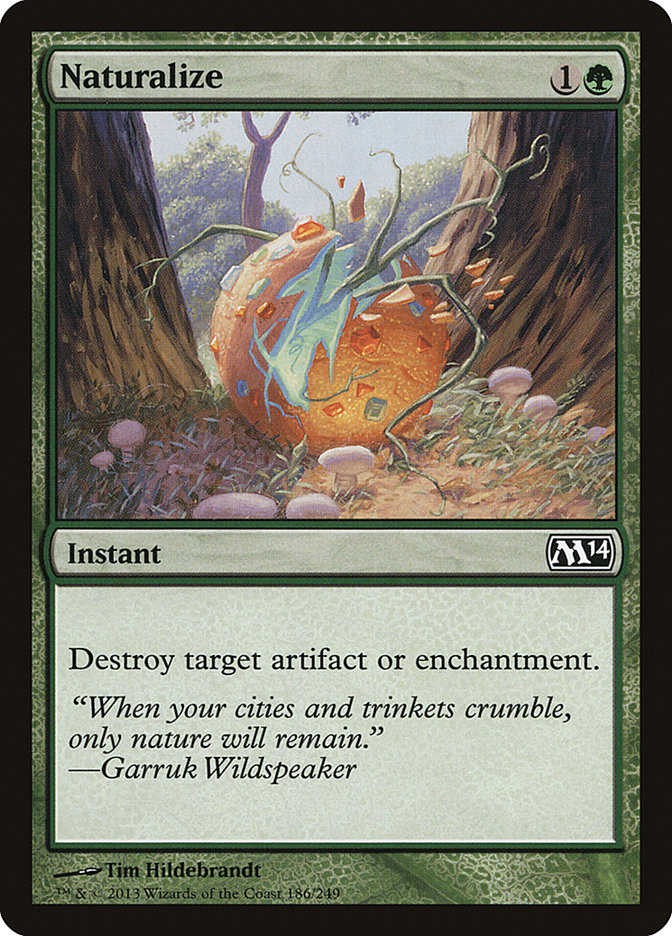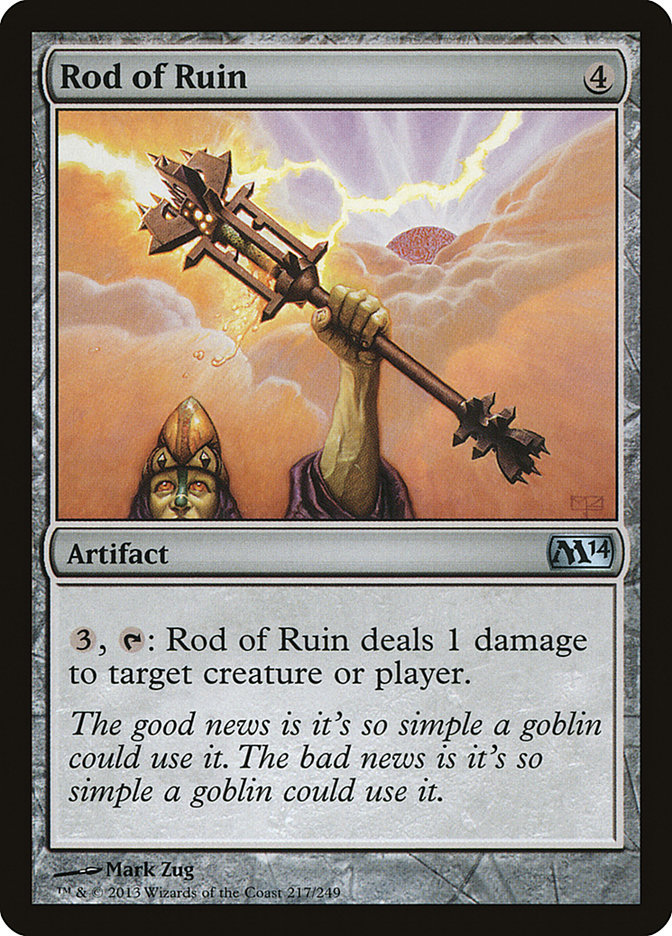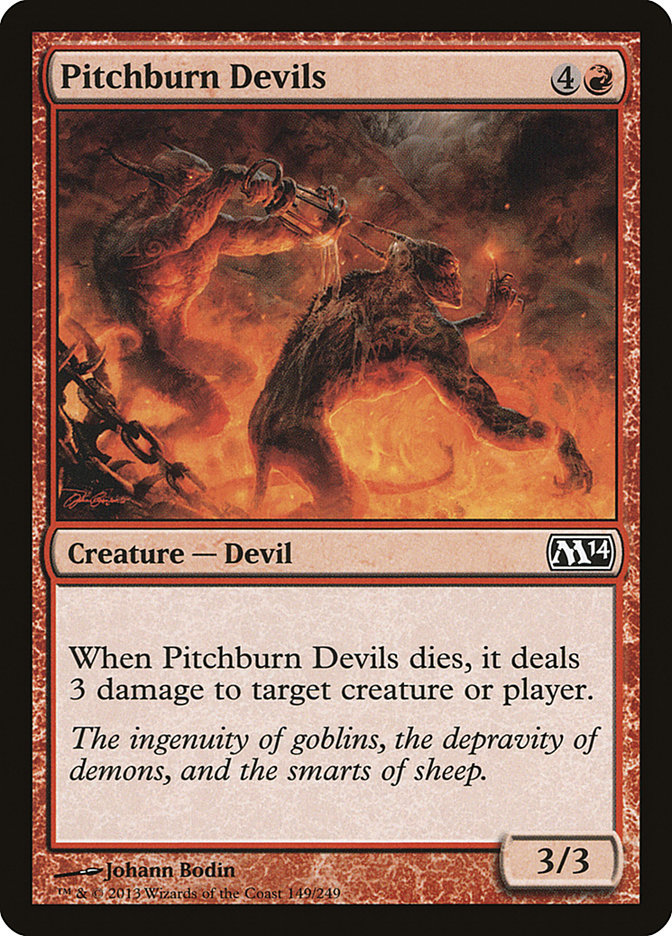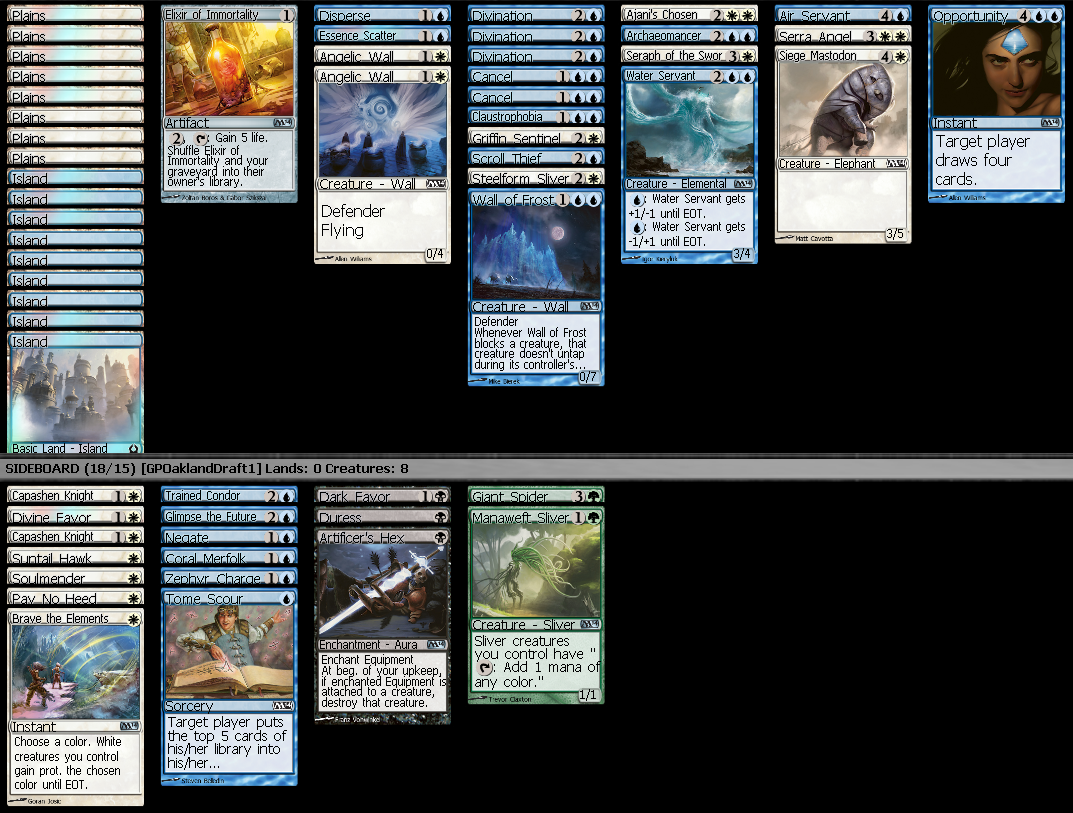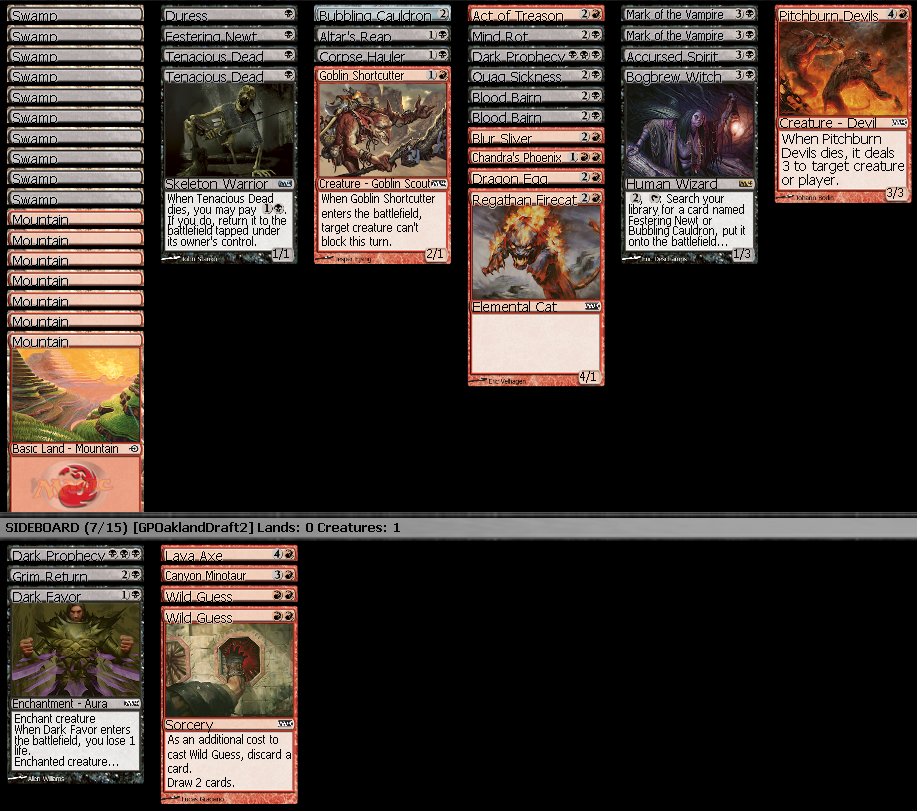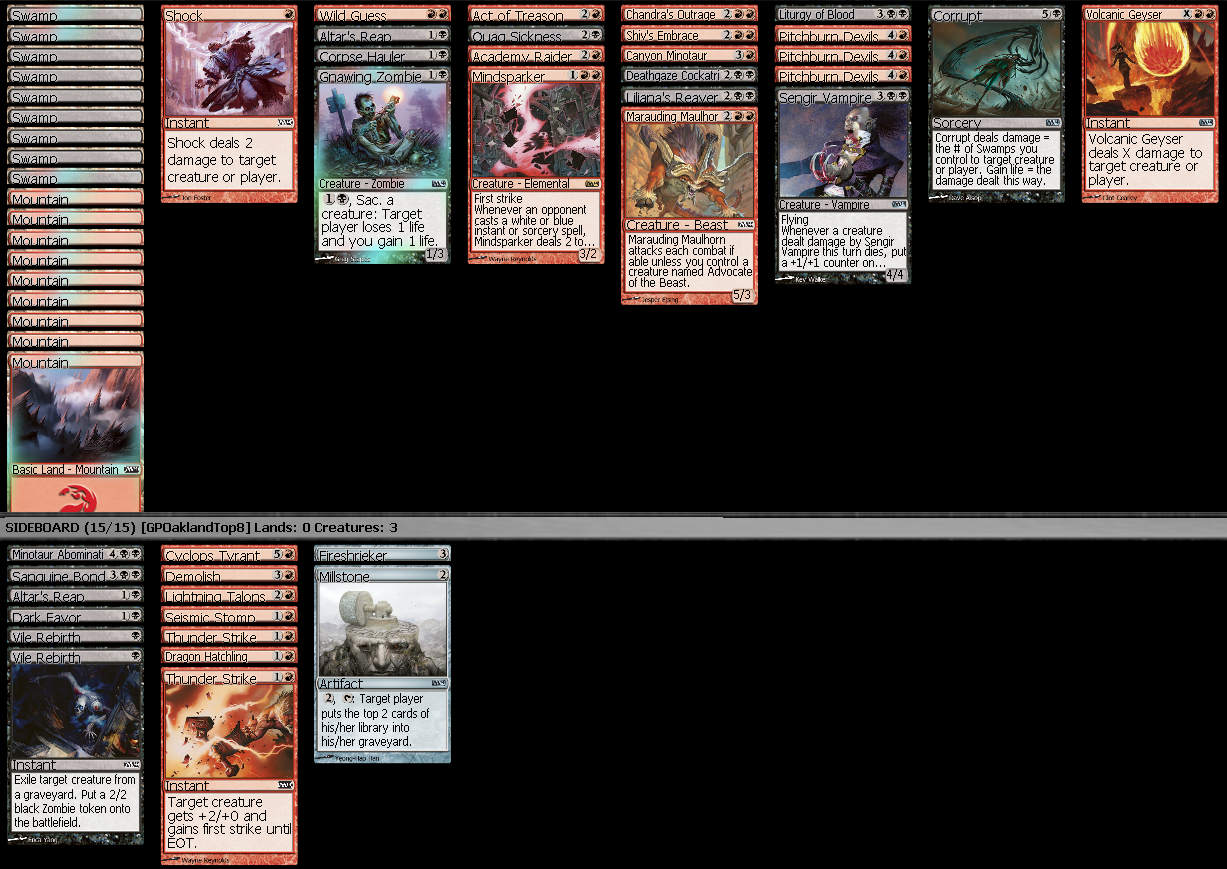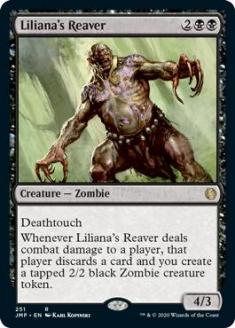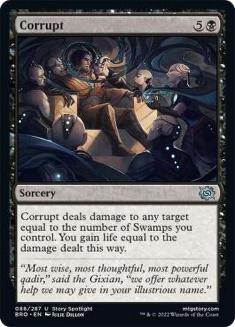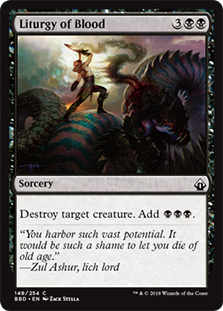After leaving the StarCityGames.com Open Series in Salt Lake City, I headed home ready to prepare for my next event, Grand Prix Oakland. The format would be M14 Limited, with day 1 being Sealed Deck and day 2 being Booster Draft. I had already played a fair amount of the format, but I was ready to really go at it hard for a couple weeks before the Grand Prix.
I’m very fortunate to have a lot of close friends who are phenomenal Magic players. Their input and advice is invaluable to my preparation for every event I play, and this one was no exception. Over the next two weeks, I spent a lot of time on Magic Online. However, I wasn’t always just firing off draft queue after draft queue. I spent a lot of nights Skyped in as a guest on Owen Turtenwald stream. Together, we were able to work through drafts, Sealed decks, and plays and figure out many intricacies of the format.
When we weren’t streaming, we were often on Skype with Reid Duke and Shahar Shenhar doing the same kinds of things. One person would draft, and the rest of us would discuss the situations as they presented themselves. In addition to all of them, my good friend and roommate Eric Froehlich was always around for me to bounce my ideas of the format off of.
After all my preparation, I really felt I had a terrific understanding of the format. I knew I wanted to play blue and that I wanted to avoid white. But I also knew that while those are general guidelines to success in M14 that I had to be open and prepared to deal with whatever decks were available to me. I made sure to spend plenty of time learning nonblue strategies, a couple of which I discussed in my last written article on this here website. I headed to Oakland with a great deal of confidence in my ability to succeed with a broad spectrum of viable archetypes.
On Saturday I arrived at the site and went to build my deck. Here is the card pool I opened:
I immediately disregarded white and black since both were exceptionally shallow. This left me with blue, red, and green. I laid out all the two-color combinations and spent a great deal of time looking at all three. The blue was just weaker than the green and the red. It had a lot of good, solid cards like two Essence Scatters and two Scroll Thiefs. It also had two great cards in Claustrophobia and Air Servant. The two Archaeomancers, aside from the Flames of the Firebrand, didn’t really have any targets that would make a big impact often enough on the board.
G/R was clearly the best choice. It had a lot going for it, including a couple premium removal spells in Flames and the Firebrand and Volcanic Geyser as well as a non-premium removal spell in Hunt the Weak. It had two Advocate of the Beasts, which combined with two Rampaging Baloths and Marauding Maulhorn are real powerhouses. It also made excellent use of my two best cards in Shivan Dragon and Ogre Battledriver. With the four four-drops I’ve already mentioned as well as two Pitchburn Devils, Woodborn Behemoth, Sporemound, and Megantic Sliver, I hoped to be able to present enough large threats to the board that the deck would simply overpower my opponents.
This was definitely an eighteen-land deck. I knew it would be imperative that I hit my fourth land on turn 4 every single game. A single turn behind on hitting those land drops and I would be in a whole lot of trouble. Because I had double spells in both colors, I opted to play nine each of Forests and Mountains.
The most borderline decision to include in the deck was Sliver Construct. I decided to play it in part because I wanted to try to get a little extra value from Megantic Sliver. It has a couple other small benefits in that it can block Accursed Spirit and Academy Raider. Also, I had only one two-drop, a Deadly Recluse. I had four other three-drops, one of which was Academy Raider. I was a little bit worried about getting draws where I didn’t have anything to play until turn 4 in which my opponent would have something to deal with my creature and I’d end up falling too far behind, unable to come back. All these things coupled with the potential to grow Sliver Construct led me to believe it was worth it.
Here is my final build:
My most interesting match of the Sealed portion of the event came in round 8 against Stephen Welch. Stephen was playing a U/W deck with a lot of flying creatures. In the first game, he got off to a very fast start with cheap flying creatures like Suntail Hawk and Coastal Drake. He also had an Imposing Sovereign, which created big problems for my slowish draw, and I drew nothing to remove it.
For game 2, I boarded in Bramblecrush, Naturalize, and Rod of Ruin. I hadn’t actually seen anything to Naturalize or Bramblecrush, but since he was U/W, I expected he’d have at least one or two very powerful enchantments like Claustrophobia or Pacifism. Because he had Suntail Hawk in his deck, I figured there was a reasonable chance he had Path of Bravery.
Also, in my experience in the 7-0 bracket at a Grand Prix, the decks you play against tend to have a very powerful high end to them. I was more or less expecting to face a planeswalker, so Bramblecrush would give me a powerful out to dealing with one if I was indeed correct. At worst, I figured I could destroy a land or one of the enchantments. As for Rod of Ruin, I saw enough one-toughness creatures in the first game that I felt it was worth boarding in.
In game 2, I got off to a reasonably good start; I was applying pressure and played a turn 4 Ogre Battledriver. My plan came to a screeching halt when Stephen’s played a fourth-turn Imposing Sovereign. This was incredibly annoying since I had no way to deal with it in my hand and it completely shut down my Ogre Battledriver, effectively turning it into a harder-to-cast Hill Giant. For this reason, I spent the next couple turns playing my creatures after combat, which is obviously unusual when you have an Ogre Battledriver in play.
Around turn 8 or 9, Stephen was at twelve life; played Jace, Memory Adept; and milled me for ten cards. I had sixteen cards left in my library. What this meant was that I had to either do twelve damage to my opponent in the next two attack phases or destroy Jace. On my turn, I decided to all-out attack at Stephen. When the dust settled, Stephen was left with no creatures, Jace was still on four counters, and his life total was at a very precarious five, while I had a Rumbling Baloth, Ogre Battledriver, and Deadly Recluse. On his turn, he drew, milled me for ten down to five cards, and played a Serra Angel. I looked through my graveyard, and my Volcanic Geyser had not yet been milled. This would win me the game on the spot if I were to draw it. I drew my card for the turn:
Being that I couldn’t get through five damage if he blocked my Rumbling Baloth with his Serra Angel, I was forced to all-out attack Jace. Stephen was able to block the Ogre Battledriver, but he lost his Jace.
This was my biggest mistake of the entire tournament.
We had played such a long game where my Ogre Battledriver was negated by Imposing Sovereign I had somehow not adjusted and left myself in that mindset. I could have simply played the Pitchburn Devils, given it haste via the Battledriver, and won the game. As it was, I was left with a Rumbling Baloth, a Deadly Recluse, and a Pitchburn Devils at eighteen life with a five-card library containing Volcanic Geyser against a Serra Angel and five life, which thankfully was still a heavily advantaged position for me.
When it comes to Magic, I’m very hard on myself when I make mistakes. However, I try very hard to not let it affect me while I’m still in a match. After the match, I’ll go for a walk, get some fresh air, or tell the story to a friend as a sort of cathartic experience. I cannot count the number of times I’ve seen players make a mistake, start to get frustrated, and then snowball it into more and more mistakes. Everyone makes mistakes. Everyone. Do your best to learn from your mistakes and move on.
Stephen wasn’t able to muster much more of a defense, and I ended up winning game 2 and forcing a game 3. Game 3 played out extremely similarly to game 2. I ended up with a horde of creatures, including an Ogre Battledriver. This time he had no Imposing Sovereign. He did, however, have Jace, Memory Adept again. Again, I opted to attack him directly instead of trying to attack the planeswalker.
There was a crucial turn in which I was going to have access to seven mana. I was going to play a Rampaging Baloth almost for sure (unless I drew something like Shivan Dragon or Megantic Sliver), but unless I drew a creature with casting cost three or less, that was going to be my only play. My draw for the turn was Deadly Recluse, giving me an extra three-power attacker thanks to the Battledriver, which I felt was enough that I could again go for Stephen’s life total and not his Jace. I calculated that Stephen would again end up at five life.
Stephen was able to play two blockers on the following turn. What this meant was I could only force through four damage with my creatures. He had one blue and one white mana. My only spell was a Rod of Ruin. I played the Rod of Ruin pre-combat to play around Negate. If he Negated it, I would just all-out attack Jace and hope to win on a later turn. If he let it resolve, I’d just all-out attack him and do the last point of damage with Rod of Ruin. I thought for a minute about whether or not there was a card that would prevent me from killing him and not prevent me from killing the Jace in the two different lines. I couldn’t come up with anything. Rod of Ruin resolved, I attacked with everything, and I did the last point of damage with the overcosted pinger.
I managed to win the final around as well, and I ended up being one of five undefeated players heading into day 2. The other undefeated players were Elliott Woo, Scott Gerhardt, Ben Lundquist, and fellow Hall of Famer elect Ben Stark. In addition to the five undefeated players, our first draft pod on day 2 would contain Alan Marling, John Patterson, and the only 8-1 player in pod 1: Eric Froehlich. There were a lot of great Magic players in this pod, but I was still very confident and ready for the draft.
In the draft, I was sitting to the immediate left of Ben Stark. I didn’t mind this, though, as I felt Ben would send me very clear signals. I started the draft by taking Air Servant over Claustrophobia. I followed it up with a Water Servant, and I was just where I wanted to be. The next pack was really bad, and I ended up taking a Manaweft Sliver. I don’t like U/G very much, but it was the best card by far, so I took it. Then I picked up my next pack and was faced with a Serra Angel. I quickly took it over a couple of middling blue cards, expecting at this point that none of the three players to my right were playing white. My plan at this point was to play U/W, and I never looked back.
Here is my final deck:
I think this is the best deck I drafted all day and one of the better decks I’ve ever had in M14. It was lacking one thing, however, and that was removal. I did manage to pick up one copy of Claustrophobia, but I was unable to get anything else, not even a Sensory Deprivation. I did have a makeshift removal package in Disperse + Cancel, but that’s a bit of a stretch.
In round 10, I was paired against Elliott Woo. Elliott was playing a very good U/R deck with an Opportunity of his own. Unfortunately for Elliott, my deck really fired on all cylinders in this match. In the first game, I cast Opportunity three times and Divination five times. He was able to cast his Opportunity, but I was too far ahead. He had to trade removal spells for my Air Servant and my Seraph of the Sword. By the time I had recycled through my library with Elixir of Immortality and began drawing all of my threats again, he was completely out of gas. It’s just impossible to keep up with someone who is drawing cards at that pace.
Game 2 was more of the same: Opportunity, Archaeomancer, Opportunity, an Elixir activation, Divination. After the match, I talked to my friend Brock Parker, who I think said it best. “I’m guessing you won. I walked away on turn 14 when you were discarding to hand size because you cast Opportunity so many times.” And he was right. I was impressed by Elliott though. I thought he had a very good deck, played really well, and did what he could to try to keep himself in the games. My deck was just too good in the control vs. control matchup.
I ended up splitting the next two rounds, with a win over Ben Lundquist and his U/W Control deck in round 11 and a loss to Alan Marling and his B/R deck in round 12. Alan’s deck matched up well against mine. He had a lot of good removal spells, a Duress to attack my hand of counters or card-drawing spells, and a Mind Rot to keep my card draw in check. Also, he had multiple copies of Deathgaze Cockatrice, which made it hard for my Angelic Walls to be very effective.
So I went 2-1 with this deck, but frankly I was disappointed with that result. However, I was 11-1 in the tournament with one draft to go, so it was tough to be unhappy with my position. I’d possibly be playing a win and in the following round, and depending on how the standings looked, I might be able to double draw. A record of 2-1 should get me in the Top 8 for sure.
As I sat down for the next draft, Elliot Woo was on my right, and to his right was his brother Travis. This was kind of amusing to me. I don’t think I’d ever had family members in succession feeding me in a high-level event like this. It was also impressive to see two brothers both doing so well in the same tournament.
This draft didn’t go nearly as well as the previous one. I started with a Quag Sickness and continued to pick up some middling black cards. I picked up an early Claustrophobia, but blue was definitely being cut, so I had to abandon it. In the meantime, I managed to get some good cards for the beginnings of a B/R Sacrifice deck. After the first pack, I had a Bubbling Cauldron, a Tenacious Dead, and a Blood Bairn. I passed some very good green cards in the first pack, but the option to switch into it wasn’t really there because there were always some decent though not as good cards in my colors.
In pack 2, I managed to pick up another Blood Bairn, an Act of Treason, and a Festering Newt. My overall card quality was still relatively weak, but so were the packs. My deck did have some very powerful things going for it. In pack 3, I managed to grab another Tenacious Dead, which I was thrilled with, and then pack 3 pick 8, the last new pack I’d see, I selected a Bogbrew Witch to complete the entire Lion/Witch/Wardrobe combo. Here is the final product:
I knew that the Tenacious Dead / Blood Bairn combo would be tough to beat. I also knew that if I could get the Bogbrew Witch active and find Bubbling Cauldron in combination with Tenacious Dead, it would also be a difficult shield for my opponent’s to penetrate. A perpetual blocker and four life per turn is not easy to overcome.
In round 13, for the second round in a row, I played against Alan Marling. This time Alan was playing a G/R creature deck. Unfortunately for him, there was very little he could do against my Tenacious Dead, Blood Bairn, and Bubbling Cauldron combo. I was able to assemble it two games in a row and win very easily. This left me at 12-1 in the tournament. I was hoping to be able to double draw in the final two rounds and lock up Top 8. However at 1,632 people, it turns out that the tournament was just too big, and I had to play. If I lost, I would have another shot in round 15. If I won, I’d be able to easily draw into the Top 8 at 13-1-1.
In round 14, I was paired against Benjamin Gomes. Benjamin was playing a hyper aggressive R/W Sliver deck with multiple copies of Hive Stirrings, Sentinel Sliver, and Striking Sliver as well as a Battle Sliver. In game 1, Benjamin was able to Chandra’s Outrage my first Blood Bairn. After that he was able to Banisher Priest my Bogbrew Witch. At this point, the only threat I really had was an Accursed Spirit.
Knowing that I would find myself in some situations like these and hoping I’d managed to run him out of creature removal spells, I slapped Mark of the Vampire on the Accursed Spirit and hoped it could go the distance. Benjamin was attacking me for seven damage per turn, but the five life gained on my attacks as well as a second Mark of Vampire on the final turn to do exactly seven damage was enough for me to win game 1.
In game 2, I kept a hand with Regathan Firecat, Bogbrew Witch, Mark of the Vampire, Tenacious Dead, and some lands. I thought this was a decent hand because if Bogbrew Witch lived it’d be powerful enough to keep me in the game. Benjamin’s hand was pretty good against mine. He led with a turn 1 Striking Sliver followed by a Hive Stirrings on turn 3. I had played out my Tenacious Dead and Regathan Firecat, and so far my draw phases had been another land and another Mark of the Vampire. Benjamin played yet another Hive Stirrings. On his fifth turn, Benjamin attacked, played a land, and passed. I hoped this meant he was land flooded and didn’t have a hand full of removal spells.
I played out my Bogbrew Witch, which was met with a Banisher Priest. I was attacked for five by the 1/1 first-striking Sliver army. On my turn, I had no choice. Having very little action, I slapped Mark of the Vampire on my Regathan Firecat. The following turn, Benjamin attacked, leaving enough first strike back to profitably block my Firecat. Given that he didn’t remove it, I thought the coast was clear. I played a second Mark of the Vampire and attacked again. Benjamin chump blocked with one of his Slivers. I was gaining a lot of life at this point, and my life total was at a healthy 24.
On the following turn, I played Dragon Egg. Ben drew and played Pacifism on my Firecat. He then all-out attacked with everything, including Banisher Priest. I was able to Altar’s Reap away my Dragon Egg, use the token to block the Banisher Priest, and get back my Bogbrew Witch. At this point, the Witch found the Cauldron, and combined with the Tenacious Dead I already had in play, Benjamin was unable to catch up before I found a Blood Bairn and put the game away.
This meant I was now 13-1 and a lock for Top 8. I took an intentional draw in round 15 with my friend Ben Lundquist. I was very happy to see Ben make Top 8, as this meant he would be qualified for Pro Tour Born of the Gods in Valencia. The draw would give me an hour where I could relax, clear my head, and get something to eat before the Top 8 started. I ended up as the top seed, which had the added benefit of allowing me to choose play/draw in game 1 of all the matches I would play in Top 8. Aside from Ben and me, the rest of the Top 8 was:
Carlos Ale
Patrick Griffin
Joshua Goldman
Travis Woo
Elliott Woo
Neal Oliver
Two brothers making Top 8 of a tournament of this size was a truly incredible feat.
The Top 8 draft went really well for me. I started with a premium removal spell in Quag Sickness. The pick that seemed to generate the most interest was my second pick of the draft. I was passed a pack where the best option for me was a Deathgaze Cockatrice. There was also a Blightcaster in the pack. A lot of people seemed to think that Blightcaster was the pick here because of my first pick Quag Sickness, but I strongly disagree.
 |
vs. |
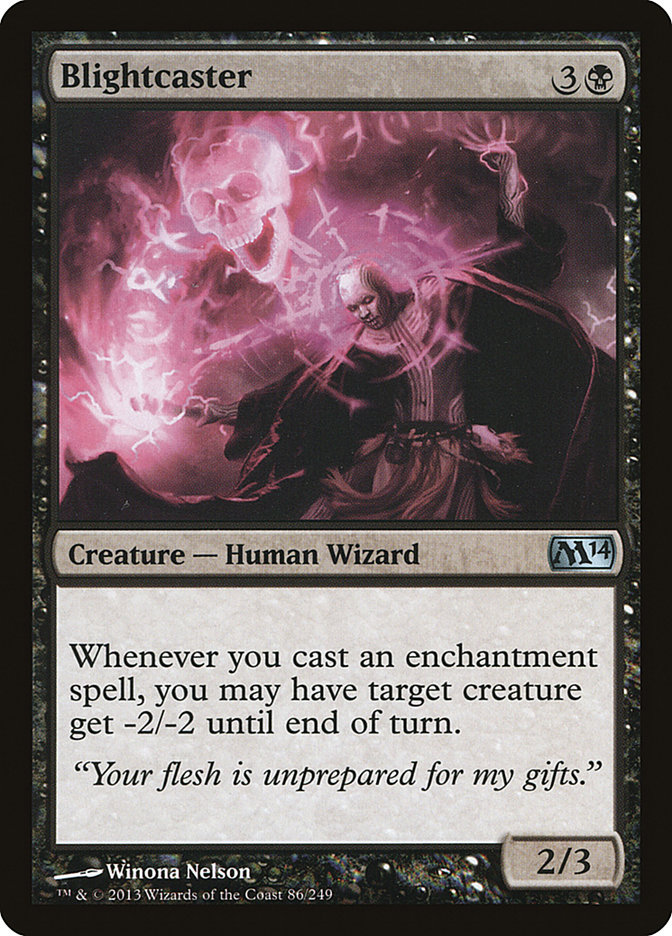 |
I find Blightcaster to be somewhat gimmicky. Also, I don’t like enchantments in this set in general, with a few obvious exceptions. The “added value” of sometimes being able to kill an extra 2/2 does not, in my opinion, make up for the fact that if unanswered the Cockatrice is able to play great defense, attack in the air, and oftentimes trade for their best creature. I was happy with the Deathgaze Cockatrice pick at the time, and I’m happy with it now.
Third pick I was able to grab a Sengir Vampire, and fourth pick I was able to draft a Corrupt. I was very happy with my deck so far. After that black began to dry up a little, and I splashed a little into both red and green. My preference with black is definitely to pair it with red over green, so I drafted accordingly. I was rewarded throughout the draft for my choice of red over green, including an eighth pick Chandra’s Outrage in pack 3.
Here is the final product:
I was very happy with this deck. I had solid creatures, great removal spells, and some card drawing (a Wild Guess and an Academy Raider) to help me get through my deck.
In the quarterfinals, I was once again paired against Elliott Woo. We split the first two games and were in a very tense game three. In that game, I had drawn only a few spells, but Elliott had been unable to draw any blue mana in a timely fashion. Eventually, he drew his blue, and I continued to draw a large number of lands. On what I knew at the time would be my final or second-to-last turn of the game, I had a board of Deathgaze Cockatrice, Pitchburn Devils, and a bunch of lands with two more in hand. I was at ten life, and Elliott was at four. Elliott had Scroll Thief, Phantom Warrior, Armored Cancrix, and a Woodborn Behemoth with exactly seven lands.
I drew Canyon Minotaur for my turn. I suspected Elliott had Giant Growth in his hand because I’d seen two in each of the previous games. Ultimately, I decided my best course of action was to attack Elliott to two with my Cockatrice. If he drew a land AND had Giant Growth, I would lose. He drew what I later found out was another Armored Cancrix and made a desperate all-out attack. I blocked in such a way that I’d survive even if he had two Giant Growths. His Woodborn Behemoth killed my Pitchburn Devils, and the game was over. This was a super-close match, but I was thrilled to be on to the semifinals.
The semifinals was not nearly as climactic as the quarterfinals. I was up against Joshua Goldman. In the first game, I was able to gain board control after removing an early Rampaging Baloth. After that Joshua was unable to mount much of an offense, and I won the game on the back of a Shiv’s Embraced Liliana’s Reaver. In the second game, Joshua missed his second land drop for several turns. My draw included both Liliana’s Reaver and Sengir Vampire. Getting stuck on two lands against those cards is an impossible spot. After the game, Joshua revealed his hand, which contained Kalonian Hydra and Garruk, Caller of Beasts. I was very fortunate that I was not forced to defeat those cards.
In the finals, I faced Neal Oliver. After the tournament, I have gone back and watched a lot of the coverage, and Neal is a phenomenal player. He plays very precisely, plays around cards very well, and shows exceptional poise. I would be paying him these compliments even if this was his first major success, but it wasn’t. A couple months ago, Neal won Grand Prix Las Vegas, which happened to be the largest Magic tournament of all time. Also, it was Modern Masters Limited, a format that is considered by a lot of the top pros to be one of the most skill-testing formats of the past several years. To win that tournament and then make the finals of the next Limited Grand Prix you enter is truly an amazing feat.
In game 1, I opted to draw first. My deck had a lot of one for ones, and I generally like drawing first in this format. This is a decision that I definitely came to regret. I ended up keeping a fairly slow hand on the draw. My first creature was a turn 3 Academy Raider. Unfortunately, Neal’s first play was a turn 3 Scroll Thief. I had nothing to remove it in my hand, and I had no two-toughness creatures that I could play to try to block it. Neal happily started drawing cards right away with the unimpeded Scroll Thief. He was able to Wring Flesh my Academy Raider as well, making me unable to try to match his Scroll Thief by increasing my hand’s quality.
I had a turn 4 Canyon Minotaur to try to throw in front of the Scroll Thief, but he had Time Ebb to put it on top of my library and get another hit in. I knew at this point the game was over. The next turn Neal played a Sengir Vampire. I had no way to remove it in my hand and very little to mount a potent offense. Neal was able to Domestication my Canyon Minotaur, which was again the only blocker for his Scroll Thief, and further his advantage. I was able to draw a Chandra’s Outrage to deal with Sengir Vampire, but I simply couldn’t overcome the card advantage that Neal had generated with his Scroll Thief and was overwhelmed by Neal’s army of creatures.
In game 2, I chose to play. Now knowing that Neal was playing a tempo deck with multiple copies of Scroll Thief and at least one copy of Time Ebb, this was certainly the correct choice. I kept a very good opening hand:
If I were to draw a Mountain in the first couple turns, I would have a tremendous curve. And being that I played eighteen lands, I was confident in my ability to put a turn 4 Liliana’s Reaver into play. I didn’t end up drawing a Mountain, and the first play of the game was Neal’s turn 3 Scroll Thief. I drew a Mountain on my fourth turn, and I had a decision to make. I could play Liliana’s Reaver, or I could cast Chandra’s Outrage, which I had also drawn, on the Scroll Thief. Ultimately, I decided to cast the removal spell. My hand was so good that I felt one way I could cost myself the game would be to play the Reaver, have it put back on top of my deck by Time Ebb, play it again, have it tapped by Claustrophobia, and fall too far behind again.
With the Scroll Thief off the board, I would be able to apply pressure with my powerful cards and force Neal to be reactive. Neal missed his fourth land drop and laid a Trained Condor. I took the opportunity to play Liliana’s Reaver. This brought about one of the more interesting situations of the finals. Neal drew and played Sensory Deprivation on the Liliana’s Reaver. He missed his fourth land drop again and passed without attacking with Trained Condor. This basically told me with absolute certainty that he had Wring Flesh in his hand.
Had he not played the Sensory Deprivation and just left the Condor on defense, I likely still would have thought long and hard about Wring Flesh. I think I would have ended up using Liturgy of Blood on the Condor anyway, but I can’t be sure. As it was, I knew he had Wring Flesh, so I cast the Liturgy on the Condor and attacked with the Reaver. Neal spent his Wring Flesh anyway to prevent discarding a card and me getting a Zombie, which was the correct play.
Next turn Neal drew Claustrophobia and had to bite the bullet and play it on my Reaver even though he had already spent one defensive enchantment card on it. Neal was almost able to achieve parity late in the game by making some negative trades with my Pitchburn Devils, but at six life an end-of-turn Volcanic Geyser for six, which got Cancelled, and then a main phase Corrupt for six, which resolved, sent us to game 3.
Unfortunately for Neal, game 3 would prove to be very anti-climactic. He was forced to mulligan his first two hands on the play and began with only five cards. His final hand was decent for a five-card hand, as he was able to at least play lands and spells. Everything broke perfectly for me though. Neal drew Domestication at a time where I had the perfect mana up to sacrifice the targeted Mindsparker to Altar’s Reap.
He also played lands on something like seven of the first eight turns and slammed a Colossal Whale. This was all he could really do; since he was so far behind on cards, he had to just hope I couldn’t deal with it. I had my Liturgy of Blood and was able to eliminate the Whale. This made the fact that Neal had drawn so many lands a real downside since he had so few cards to begin with. Neal was never able to recover from his unlucky start, and I was able to take the game and the Grand Prix Oakland Championship.
In my opinion, you can tell a lot about a person by how they handle themselves in situations of extreme misfortune. Neal was relatively unlucky in game 2 and extremely unlucky in game 3. In the face of all that, Neal was extremely polite and gracious in defeat. I’d like to reiterate how impressed I was with Neal’s play and accomplishments, and I expect nothing but continued success from him.
I was so incredibly happy to have won the tournament and become Grand Prix Oakland Champion. After getting twenty or so high fives, I headed to the booth for a quick interview with Marshall Sutcliffe. I was so happy and excited that I could barely answer his questions coherently. I really wanted to prove to myself that “I still had it,” and I was just so incredibly proud and happy to be able to do that.
Up next for me will be Modern at Grand Prix Detroit. For the first time in thirteen years, I’ll have the chance to win back-to-back Grand Prix events. Wish me luck!

